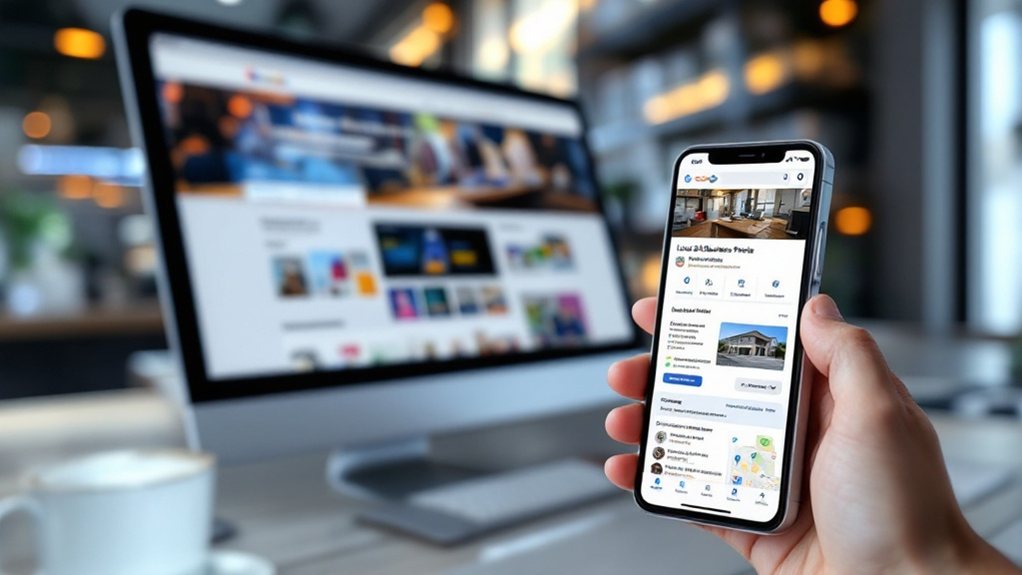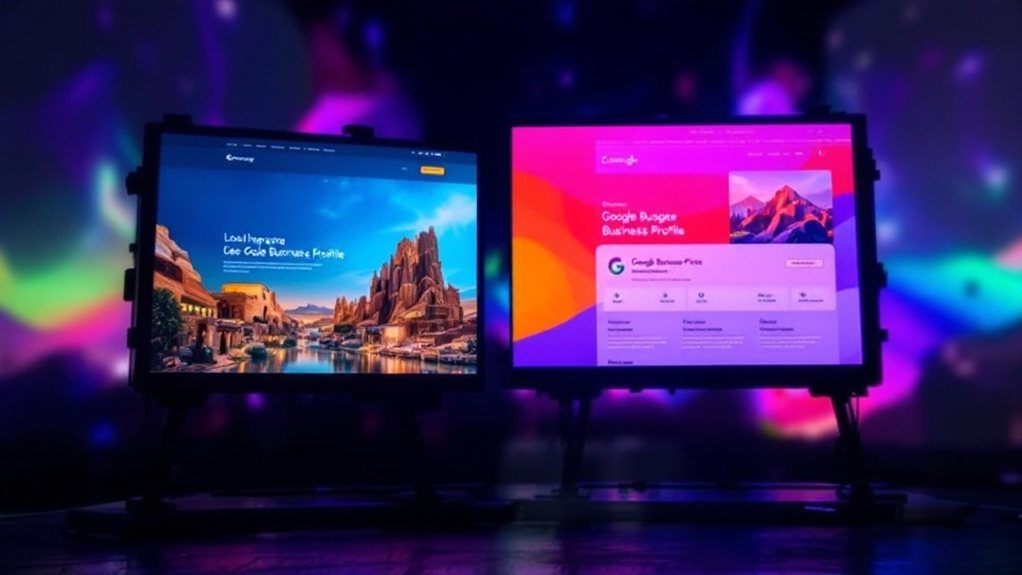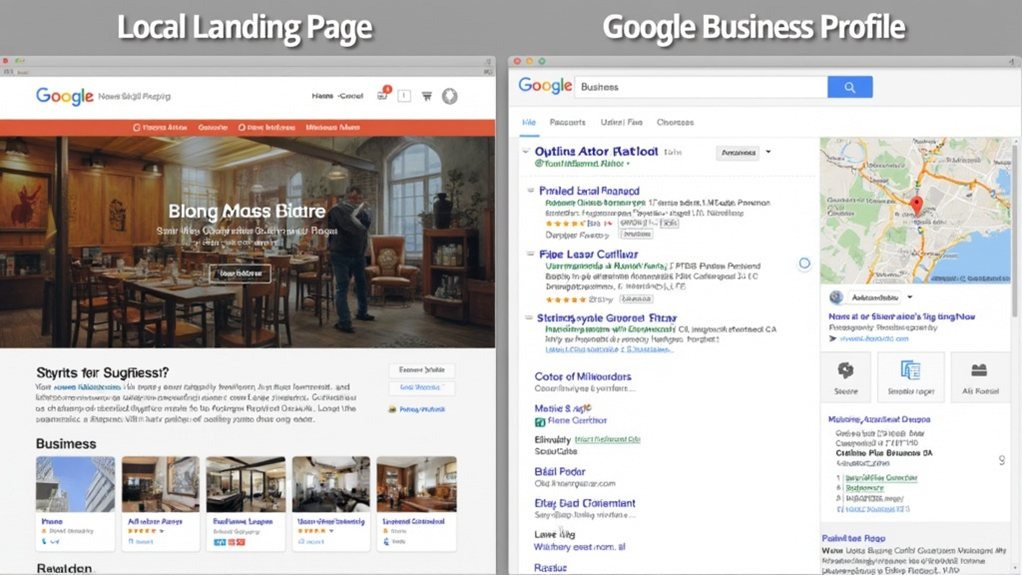Local landing pages and Google Business Profile pages both play key roles in your local SEO strategy. Landing pages offer targeted content for specific regions, boosting visibility in local search. Google Business Profiles provide basic business info and customer interaction on Google platforms. To optimize your local presence, you'll want to leverage both – creating engaging, localized content while ensuring a complete and consistent Google Business Profile. Keep reading to dive deeper into integrating these elements for maximum impact.
Understanding the Purpose and Functionality

Understanding the purpose and functionality of local landing pages and Google Business Profile pages is crucial for businesses looking to optimize their local online presence. Local landing pages provide targeted content tailored to specific geographic regions, enhancing visibility in local search results and improving customer engagement. Leveraging local connections and user engagement is a key aspect of effective local landing pages. Conversely, Google Business Profiles offer basic business information and visibility on Google platforms, allowing for customer interaction and reviews. While local landing pages offer more customization and detailed insights, Google Business Profiles are essential for consistent business listings across Google. Businesses must leverage both to effectively manage their local online presence and maximize their marketing impact.
Optimizing for Local SEO

Optimizing for Local SEO goes beyond simply understanding the purpose and functionality of local landing pages and Google Business Profiles. To truly drive engagement and conversions, you need to focus on tailoring your content, leveraging local keywords, and enhancing the user experience. This includes identifying your target audience, creating localized content, conducting keyword research, optimizing your SEO, and designing mobile-friendly websites. Incorporating these strategies can significantly boost your local search visibility and lead to higher conversion rates. Proper optimization of local landing pages and Google Business Profiles is crucial for effective Local SEO.
| Local Landing Page Optimization | Google Business Profile Optimization |
|---|---|
| Localized Content | Accurate Business Info |
| Targeted Keywords | Positive Reviews |
| Device Compatibility | Local Schema Markup |
| Conversion Tracking | Regular Updates |
| Analytics Integration | Engagement with Customers |
Leveraging Google Business Profile

Optimizing your Google Business Profile (GBP) can significantly boost your local visibility. From displaying key business details to facilitating customer interactions, leveraging GBP features can give you a competitive edge. Local Search Visibility can improve your prominence in Google search and maps, increasing the chances of appearing in the Google 3-pack. Aligning your GBP with strategic location pages can further enhance your local SEO and drive more qualified traffic to your business.
Optimizing GBP for Visibility
A complete Google Business Profile can significantly impact your conversion rates, as it provides users with more information about your business. Ensuring your business name clearly reflects real-world usage is crucial, and maintaining accurate, up-to-date contact details is essential. For businesses serving areas outside their location, define up to 20 service areas within a reasonable driving distance. Consistency is key – maintain uniform NAP (name, address, phone number) across directories to improve visibility. Leverage factual attributes like accessibility or pet-friendliness to enhance user experience and search relevance. Including products on your profile can boost rankings and engagement, while regular posts and reviews can increase visibility and trust. [Regularly updating your profile with new content can keep it fresh and engaging for potential customers.
Integrating GBP With Location Pages
One key way to leverage your Google Business Profile (GBP) is by integrating it with your location-specific pages. This allows you to deliver a more tailored, relevant experience for customers. By linking your GBP to specific service pages, you can enhance visibility for targeted keywords. For multi-location businesses, each GBP should link to a local page rather than a corporate site to maximize local relevance. Ensuring the search for the target keyword returns a map pack can further bolster local visibility.
Some additional benefits of integrating GBP with location pages include:
- Improved local SEO through complementary platforms.
- Increased credibility and trust via consistent NAP information.
- Enhanced user experience by directing customers to relevant content.
- Deeper insights through centralized GBP management and analytics tracking.
Creating Engaging Content
Crafting compelling business descriptions, optimizing imagery and media, and integrating interactive map features can elevate your local landing pages. Localized content speaks directly to the customer, fostering trust and relevance. These elements engage users, showcase your unique offerings, and guide them toward conversions. Invest in creating engaging content to elevate your local presence and outshine your competition.
Compelling Business Descriptions
Compelling business descriptions are the cornerstone of engaging local landing pages and Google Business Profile pages. By prioritizing:
- Consistent branding and messaging across platforms to enhance credibility.
- Location-specific content to improve relevance for local searches.
- Customer-focused language that addresses local needs and preferences.
- Clear service descriptions and strong calls-to-action to encourage visitor action.
Businesses can craft descriptions that captivate local audiences, highlight unique selling points, and leverage customer testimonials and data to showcase their value proposition. Analyzing financial ratios can provide valuable insights to inform these compelling business descriptions. Optimizing for location-specific keywords and aligning with Google My Business listings further amplifies the impact of these compelling business descriptions.
Optimized Imagery and Media
Beyond crafting compelling business descriptions, optimizing the imagery and media on your local landing pages and Google Business Profile can further engage your target audience. Visuals that enhance the user experience, like high-quality images and videos, can boost engagement rates and improve your local SEO rankings. Ensure your media is mobile-friendly and fast-loading to provide a seamless experience. Leverage localized themes, customer testimonials, and storytelling techniques to create content that resonates with your local customers. Optimize image alt tags, file names, and compression to enhance search engine visibility. Videos have the greatest impact on conversions for landing pages according to 38.6% of marketers. Ultimately, strategic media optimization supports local conversions by building credibility and aligning with geographic search intent.
Interactive Map Integrations
Why not leverage interactive map integrations to create truly engaging content on your local landing pages? Compared to static maps, interactive versions provide a dynamic user experience, allowing customers to explore locations more immersively. Many tools, like Unbounce Apps and Instapage, offer easy-to-use map embedding functionality, no coding required. You can customize maps with branded markers, colors, and pop-ups to align with your business identity. Additionally:
- Interactive maps can improve customer engagement, reducing bounce rates and boosting conversions with clear location details.
- Maps contribute to increased local visibility in Google searches, highlighting your specific business locations.
- Tailoring map content to each location enhances relevance and boosts your chances of appearing in the Map Pack.
- Analytics integration helps measure the effectiveness of your interactive map implementations.
- The Map App within Unbounce Apps is one such tool that enables easy integration of interactive maps on your landing pages.
Enhancing User Experience
Enhancing the user experience on local landing pages and Google Business Profile (GBP) pages is crucial for driving engagement and conversions. Content customization, interactive elements, and visual engagement can all contribute to a more compelling user experience. Tailoring content to specific geographic areas, incorporating FAQs and videos, and using images and graphics can significantly boost user interaction. The content on the specific URL linked to GBP holds substantial weight and directly influences local ranking results. Additionally, highlighting a business's services on GBP pages and ensuring mobile-friendliness are key factors. By focusing on these elements, you can create engaging local pages that meet users' needs and encourage them to take desired actions.
Integrating Technical Considerations
Optimizing local landing pages and Google Business Profile (GBP) pages for technical considerations is equally important as enhancing the user experience. Here are four key technical factors to integrate:
- Ensure SEO optimization, including location-based URLs, targeted keywords, consistent NAP, custom meta tags, and structured data.
- Prioritize mobile responsiveness with fast loading speeds, large text, and easy navigation to cater to Google's mobile-first indexing.
- Implement effective internal navigation and links, guiding users to specific service pages and facilitating search engine crawling.
- Leverage visual content like Google Maps, high-quality images, and videos to provide an immersive experience and support local SEO.
Conducting Competitive Analysis
Conducting a thorough competitive analysis is crucial when optimizing your local landing pages and Google Business Profile (GBP) pages. Start by identifying your local competitors, then analyze their GBP optimization tactics, reviews, and engagement metrics. Understand their SEO strategies, including keyword targeting and schema markup. Compare the design, user experience, and content quality of their local landing pages. Use these insights to identify gaps in your own strategy and optimize your content accordingly. Focus on targeting long-tail keywords and engaging with your local audience. Continuously monitor your competitors' moves and make iterative improvements to stay ahead. Leverage SEO tools to streamline your competitive analysis and optimization efforts.
Measuring Performance and Metrics
Tracking conversions and sales is crucial to understanding the performance of your local landing pages and Google Business Profile. Monitoring search visibility through metrics like total search impressions and website clicks can reveal how well your profiles are performing. Analyzing user engagement, such as time on page and click-through rates, can help you optimize content to better match searcher intent.
Tracking Conversions and Sales
Measuring the performance of your landing pages and Google Business Profiles is crucial for driving conversions and achieving your marketing goals. Track key metrics like:
- Conversion Rate: Understand the percentage of visitors who complete a desired action, such as signing up or purchasing.
- Form Submission Rate: Analyze how often users engage with interactive elements on your pages.
- Bounce Rate: Identify usability issues by monitoring the percentage of visitors leaving without interaction.
- Scroll Depth: Assess how far users scroll, ensuring your key content is seen and interacted with.
Leverage Google Analytics to collect and analyze these insights, then optimize your pages and marketing strategies accordingly.
Monitoring Search Visibility
How do you monitor your search visibility and optimize for local search performance? Start by tracking key performance indicators like local search rankings, organic traffic from local visitors, and click-through rates. Analyze keyword performance metrics and stay updated on search engine algorithm changes. For your Google Business Profile, focus on completeness, review management, and insights. Use tools like Google Analytics, Google Search Console, and SEO software to segment local data and benchmark against competitors. Pay attention to page impressions, conversions, and local search factors like relevance, proximity, and prominence. Continuous performance analysis ensures your local SEO strategies adapt to market shifts.
Analyzing User Engagement
Understanding and analyzing user engagement metrics is crucial for evaluating the performance of your local landing pages and Google Business Profile. Conversion rate, engagement rate, average time on page, and bounce rate provide valuable insights into how users interact with your content. To further optimize, track metrics like:
- Scroll depth to gauge content engagement
- Page views to understand traffic and potential for conversions
- Device profiles to ensure consistent user experience
- Geolocation data to enable targeted marketing strategies
Leverage data from tools like Google Analytics 4 and A/B testing to continuously refine your landing pages and boost user engagement.
Aligning Strategies for Location-Specific Needs
When aligning your content strategies for location-specific needs, you'll want to ensure that both your local landing pages and Google Business Profile pages are optimized for relevant, location-focused keywords. This means incorporating city or state-specific keywords in your title tags and H1 headings, and utilizing local SEO tools to find the right long-tail phrases. Maintaining consistent NAP (Name, Address, Phone Number) across all pages and listings is also crucial for SEO benefits. Additionally, producing unique and localized content for each location page can better engage your target audiences. By optimizing your local presence, you can bypass competition from broader search terms and appeal to users' geographic context.
Maintaining Consistency and Credibility
Maintaining consistent and credible business information across online platforms is crucial for local SEO success. Ensure your name, address, and phone number (NAP) are precisely the same on your Google Business Profile, website, and local directories. Update your business hours promptly as changes occur. Regularly audit your listings to fix any discrepancies that could harm your credibility. Properly categorize your business on Google to ensure accuracy.
- Keep your NAP consistent across all online listings.
- Update business hours immediately when they change.
- Regularly audit and correct any inconsistencies in your listings.
- Accurately categorize your business on Google Business Profile.
